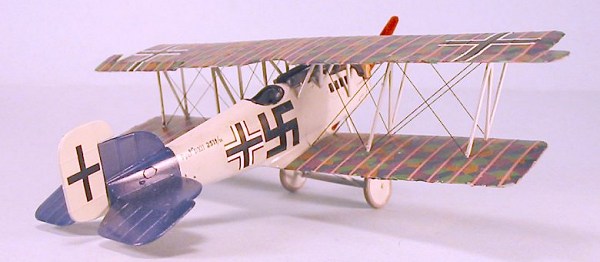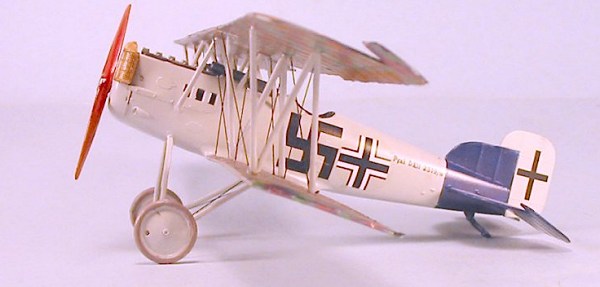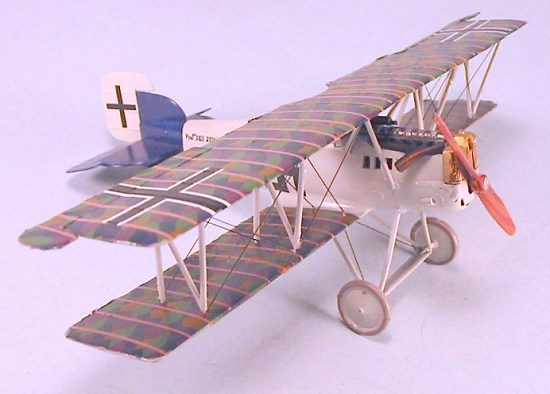
Special Hobby 1/48 Pfalz D.XII
| KIT #: | ? |
| PRICE: | $29.95 MSRP |
| DECALS: | Two options |
| REVIEWER: | Tom Cleaver |
| NOTES: |

| HISTORY |
The Pfalz D.XII - a thoroughly competent fighter produced by a design team that had created the highly-regarded D.III series - had the misfortune to arrive on the Western Front at the same time as the magnificent Fokker D.VII, compared to which any other contemporary aircraft design was bound to suffer in the view of pilots who wanted to fly only the best.
In creating the D.XII, Chief Designer Rudolph Geringer strove to solve the one major criticism of the D.III series, the weakness of the sesquiplane layout, which prevented its pilots throwing it around in combat with the complete abandon necessary to achieve true greatness. Both the Pfalz D.III and the Albatros D.III and D.V had - unfortunately! - been influenced by the Nieuport sesquiplanes; the design worked for lightly-loaded airplanes like the Nieuports, but not for more heavily-loaded airplanes with inline engines like the Pfalz and Albatros fighters. The D.XII was influenced by the S.P.A.D. VII and XIII fighters which were fast, heavily-loaded and able to out-dive all German fighters they opposed until the advent of the Fokker D.VII.
 The First Fighter Competition in January 1918 was a watershed event for
German fighter development. German pilots demanded that German designers
concentrate on speed over maneuverability, as their Allied opponents were
doing. The Fokker D.VII won the competition and went on to achieve large
production orders. The D.XII was still under construction and unable to
take part in this event. When the prototype did fly in March 1918, its
performance was judged sufficiently good to merit a production order for 50
in April, ahead of the Second Fighter Competition that was eventually held
that May. These first 50 D.XIIs - and the other 150 of the first
production run - differed visually from what would be the eventual
production standard by the use of a rectangular fin and rudder.
Unfortunately for Pfalz, the BMW.IIIa engine just coming into production -
which significantly improved the performance of the D.XII - was in short
supply and Idflieg assigned all available engines to Fokker D.VIIf
production, forcing Pfalz to power the D.XII with the inferior Mercedes
D.III engine.
The First Fighter Competition in January 1918 was a watershed event for
German fighter development. German pilots demanded that German designers
concentrate on speed over maneuverability, as their Allied opponents were
doing. The Fokker D.VII won the competition and went on to achieve large
production orders. The D.XII was still under construction and unable to
take part in this event. When the prototype did fly in March 1918, its
performance was judged sufficiently good to merit a production order for 50
in April, ahead of the Second Fighter Competition that was eventually held
that May. These first 50 D.XIIs - and the other 150 of the first
production run - differed visually from what would be the eventual
production standard by the use of a rectangular fin and rudder.
Unfortunately for Pfalz, the BMW.IIIa engine just coming into production -
which significantly improved the performance of the D.XII - was in short
supply and Idflieg assigned all available engines to Fokker D.VIIf
production, forcing Pfalz to power the D.XII with the inferior Mercedes
D.III engine.
The D.XII began to arrive among the active squadrons during July 1918. Many Jastas operated both the Fokker D.VII and Pfalz D.XII together. Leutnant Rudolf Stark, commander of Jasta 35, said, “During the larger operations, we flew the Fokker D.VII and the Pfalz D.XII mostly together. Both types were similar but the Fokker was more maneuverable. Therefore the Pfalz pilots had orders from me, during attacks by the enemy, to fly below the Fokkers.” Units in quieter sectors of the front were completely equipped with the D.XII.
 The airplane was not easy to fly and pilots had difficulty with it. Pilots
reports indicated that the airplane climbed well and could dive faster than
the D.VII, but it tended to lose height rapidly in a tight turn and could
not compete with the D.VII in terms of maneuverability. On said, “The
Pfalz was a sluggish work horse which fought bridle and had to be
controlled with a strong halter.” Others reported it had flying qualities
much like the SPAD, having an abrupt stall and a tendency to spin with
little provocation. Due to the design differences of the wing, it could
not “hang on its nose” like the D.VII.
The airplane was not easy to fly and pilots had difficulty with it. Pilots
reports indicated that the airplane climbed well and could dive faster than
the D.VII, but it tended to lose height rapidly in a tight turn and could
not compete with the D.VII in terms of maneuverability. On said, “The
Pfalz was a sluggish work horse which fought bridle and had to be
controlled with a strong halter.” Others reported it had flying qualities
much like the SPAD, having an abrupt stall and a tendency to spin with
little provocation. Due to the design differences of the wing, it could
not “hang on its nose” like the D.VII.
The Pfalz D.XII did relieve the shortage of fighters on the Western Front and was a more than adequate replacement for the 470 Pfalz. DIIIa and Albatros D.Va fighters still in front line service on August 1, 1918. Had it appeared in March, with the superlative BMW.IIIa engine, its reputation would be far different.
Several D.XIIs were taken to the United States after the war, and following tests by the U.S. Army Air Service, they were sold as surplus. Three ended up being used by Howard Hughes for the flying sequences of his aviation epic, “Hells Angels,” and two were later used in both the 1932 and 1936 versions of “Dawn Patrol.” At least one still exists in what was the Champlin Fighter Collection, which is now part of the Seattle Museum of Flight.
| THE KIT |
There have been three kits of the D.XII in 1/48 prior to the release of
this kit from Special Hobby during the past summer. The first two were a
decent vacuform from Tom’s Modelworks released in the late 1980s that can
still be found among collectors and makes into an accurate model, and a
very poor resin kit made from the Tom’s Modelworks masters released by a
company that shall remain mercifully unremembered for that individual’s
complete lack of talent in resin casting (wings
 with 1/8" thick
flat
trailing edges!!). Third was a very good kit released by Blue Max about
1998, that is now long out of production, though it can be found among
collectors.
with 1/8" thick
flat
trailing edges!!). Third was a very good kit released by Blue Max about
1998, that is now long out of production, though it can be found among
collectors.
This kit by Special Hobby makes up into an early-production D.XII, and is definitely the best of the bunch, even with the problems outlined below. Produced in injection-molded plastic, it fully captures the sturdy-yet-delicate look of the D.XII, with very thin flying surfaces that have excellent fabric effect, and struts that are thin enough to look accurate, and just strong enough to do their duty; be careful with these during construction, because they are delicate enough to break easily. These struts give a much more delicate appearance to this model than can be achieved with the Blue Max kit, since the pewter struts of the earlier kit cannot be done in a scale thickness; however, the Blue Max kit looks more like the late-production D.XII, which did have beefed-up landing gear and interplane struts.
The detail parts are in well-cast resin, providing the very prominent radiator, guns and engine, and a cockpit that is undersize enough to be noticeable. I replaced the floor and seat in the kit with sheet plastic and a seat left over from another kit that was more accurate.
Decals are provided for two aircraft. When the kit first came out, there were complaints about the fact that there was only provision for upper-surface lozenge. In checking this out, World War I Aviation uber-guru Robert Karr informed me that many D.XIIs had the lower surface lozenge fabric repainted in light blue at the factory. Since I decided to use the really excellent Blue Max 4-color lozenge, this was not a problem for my project.
| CONSTRUCTION |
Construction was really quite simple. I cleaned up the very little bit of
flash on the parts, then separated the control surfaces and glued them in a
more dynamic look. I decided at this time to make a model of one of the
first 200 D.XIIs
with the rectangular rudder and fin, so the finished model would look
different from the Blue Max model in my collection.
200 D.XIIs
with the rectangular rudder and fin, so the finished model would look
different from the Blue Max model in my collection.
 The interior of the cockpit is easy: the whole thing was painted light
grey. I used lead foil to make the seatbelts, closed up the fuselage, and
sanded away the centerline seam.
The interior of the cockpit is easy: the whole thing was painted light
grey. I used lead foil to make the seatbelts, closed up the fuselage, and
sanded away the centerline seam.
The engine fit easily in the nose. I left off the radiator and the gun troughs until after the model was painted and decaled. I attached the lower wing, horizontal tail surfaces and vertical fin prior to picking up the airbrush.
| COLORS & MARKINGS |
Painting:
I used a profile of a Jasta 77b D.XII from Bob Pearson’s excellent CD of World War I aircraft markings. I painted the whole model light grey using Gunze Sangyo “Aircraft Grey.” I then masked off the forward fuselage and painted the tail blue using Tamiya X-4 “Blue.” The radiator was painted Brass, then overpainted with Tamiya “Smoke” to pop-out the detail.
 Decals:
Decals:
The lozenge was done with Blue Max 4-color lozenge, applied in chord-wise sections, with the salmon-colored rib tapes used to make a nice color difference with the other lozenge-marked aircraft in my collection that have the light blue rib tape. The individual swastika marking came from the decal dungeon, and I used the kit decals for the national insignia.
Final Assembly:
When all the decals were set and Futured for protection, I mounted the radiator, the gun troughs, and the machine guns. I then attached the cabane struts and then the exhaust, so I could insure they fit together correctly. The joints on the cabane struts were strengthened with tiny applications of cyanoacrylate glue, and then I attached the interplane N-struts. All these joints were strengthened with cyanoacrylate. When that was done, I attached the landing gear and the propeller. The upper wing was done last, with attachment being done strut by strut, from the cabane struts to the outer N-struts.
The rigging is fairly simple if you've done a few WWI types before, and was done with .008 wire.
| CONCLUSIONS |
The D.XII is a good-looking airplane that “coulda been a contendah” had its timing been better. It certainly belongs in any definitive collection of World War I fighters. The kit is no more fiddly than the Roden Fokker D.VII kits.
December 2004
Copyright ModelingMadness.com. All rights reserved. No reproduction in part or in whole without express permission.
If you would like your product reviewed fairly and fairly quickly, please contact the editor or see other details in the Note to Contributors.
Back to the Review Index Page 2016